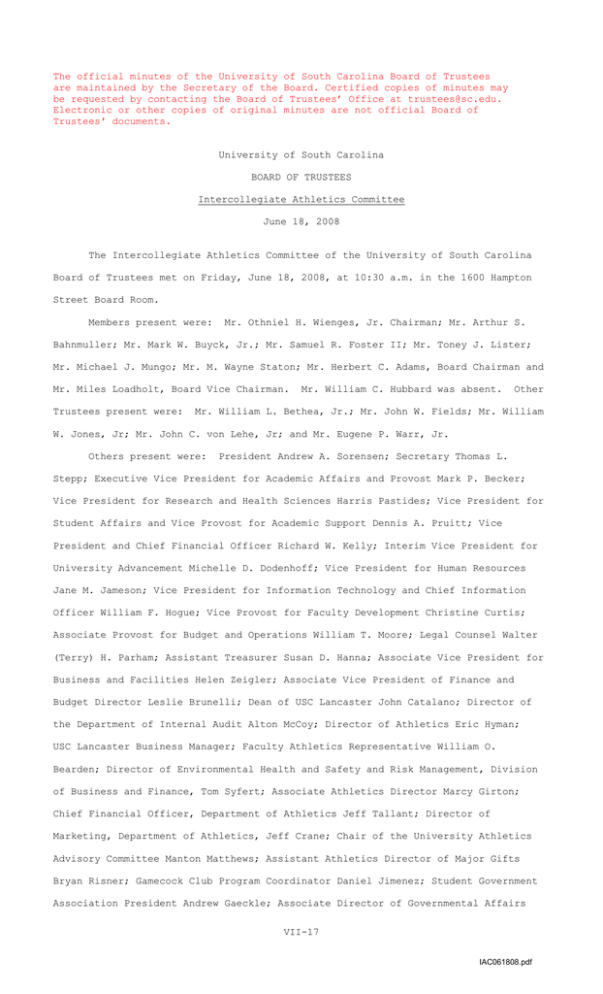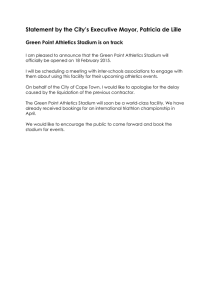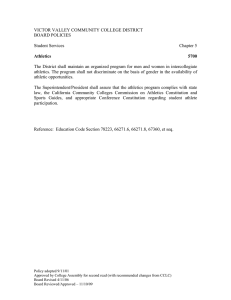The official minutes of the University of South Carolina Board... are maintained by the Secretary of the Board. Certified copies...
advertisement

The official minutes of the University of South Carolina Board of Trustees are maintained by the Secretary of the Board. Certified copies of minutes may be requested by contacting the Board of Trustees’ Office at trustees@sc.edu. Electronic or other copies of original minutes are not official Board of Trustees' documents. University of South Carolina BOARD OF TRUSTEES Intercollegiate Athletics Committee June 18, 2008 The Intercollegiate Athletics Committee of the University of South Carolina Board of Trustees met on Friday, June 18, 2008, at 10:30 a.m. in the 1600 Hampton Street Board Room. Members present were: Mr. Othniel H. Wienges, Jr. Chairman; Mr. Arthur S. Bahnmuller; Mr. Mark W. Buyck, Jr.; Mr. Samuel R. Foster II; Mr. Toney J. Lister; Mr. Michael J. Mungo; Mr. M. Wayne Staton; Mr. Herbert C. Adams, Board Chairman and Mr. Miles Loadholt, Board Vice Chairman. Trustees present were: Mr. William C. Hubbard was absent. Other Mr. William L. Bethea, Jr.; Mr. John W. Fields; Mr. William W. Jones, Jr; Mr. John C. von Lehe, Jr; and Mr. Eugene P. Warr, Jr. Others present were: President Andrew A. Sorensen; Secretary Thomas L. Stepp; Executive Vice President for Academic Affairs and Provost Mark P. Becker; Vice President for Research and Health Sciences Harris Pastides; Vice President for Student Affairs and Vice Provost for Academic Support Dennis A. Pruitt; Vice President and Chief Financial Officer Richard W. Kelly; Interim Vice President for University Advancement Michelle D. Dodenhoff; Vice President for Human Resources Jane M. Jameson; Vice President for Information Technology and Chief Information Officer William F. Hogue; Vice Provost for Faculty Development Christine Curtis; Associate Provost for Budget and Operations William T. Moore; Legal Counsel Walter (Terry) H. Parham; Assistant Treasurer Susan D. Hanna; Associate Vice President for Business and Facilities Helen Zeigler; Associate Vice President of Finance and Budget Director Leslie Brunelli; Dean of USC Lancaster John Catalano; Director of the Department of Internal Audit Alton McCoy; Director of Athletics Eric Hyman; USC Lancaster Business Manager; Faculty Athletics Representative William O. Bearden; Director of Environmental Health and Safety and Risk Management, Division of Business and Finance, Tom Syfert; Associate Athletics Director Marcy Girton; Chief Financial Officer, Department of Athletics Jeff Tallant; Director of Marketing, Department of Athletics, Jeff Crane; Chair of the University Athletics Advisory Committee Manton Matthews; Assistant Athletics Director of Major Gifts Bryan Risner; Gamecock Club Program Coordinator Daniel Jimenez; Student Government Association President Andrew Gaeckle; Associate Director of Governmental Affairs VII-17 IAC061808.pdf and Legislative Liaison Casey Martin; Director of University Communications, Division of University Advancement, Russ McKinney, Jr.; Board staff members Terri Saxon, Vera Stone, Karen Tweedy; and members of the press. Chairman Wienges called the meeting to order and invited those present to introduce themselves. attendance. Mr. McKinney introduced members of the media who were in Chairman Wienges stated that notice of the meeting had been posted and the press notified as required by the Freedom of Information Act; the agenda and supporting materials had been circulated to members of the Committee; and a quorum was present to conduct business. I. Athletics Director’s Report: Chairman Wienges called on Mr. Hyman who reported on several initiatives in the Athletics Department. The baseball stadium was nearly 50 percent completed and would be one of the best in the country. extended an invitation to the Board to go over and look at the project. He A couple of months ago, several potential donors and the press had visited the site so they could get a sense of the new stadium. The new training room at the Williams-Brice stadium, a $2.5 million project, would be completed in two to three months and would be a state-of-the-art facility. In July, ground would be broken for the Academic Enrichment Center. Rising seniors in high school now would be occupying this facility during their freshmen year at USC. The goal was to have students achieve success on the field of competition as well as in the classroom. The Center would enhance the opportunities for students to reach their dreams academically. This project would have one of the biggest impacts in the last 15 to 20 years in Athletics. The ground breaking ceremony was held three months ago and everything went well. There was much enthusiasm and excitement in the Athletics Department as well as Gamecock Nation, because everyone could finally visualize this project which had been discussed over an extended period of time. Mr. Hyman said this would be an exciting season for the men’s and women’s basketball program, especially with the new Head Women’s Basketball Coach, Dawn Staley, and the new Head Men’s Basketball Coach, Darrin Horn. Coach Staley could get into almost any door in the country for potential prospects for the women’s basketball team. Also, Coach Horn had a great reputation and was smart and energetic. Mr. Hyman was very pleased with the Athletics Department’s budget process and the five year forecast. He commended the Department’s Chief Financial Officer, Jeff Tallant, for his efforts. Overall, their main objective for next fiscal year was to have 15 percent of the Athletics Department operating budget in a reserve account. A couple of years VII-18 IAC061808.pdf ago, the operating budget was $3.5 million, and the reserve account had been depleted. Mr. Bahnmuller inquired as to whether the new baseball stadium would be completed by next spring and the status of the expansion of the football stadium. Mr. Hyman responded, yes, the stadium would be completed by spring. Also, the Board had approved a contract to hire a firm to help the Athletics Department with strategic planning on the stadium. These experts would advise the University on what should be done from a strategic standpoint with anticipation of program growth. This process would take approximately three to four more months and the Administration would report back to the Board. Mr. Wienges stated that the Athletic Director’s Report would be received as information. II. Department of Athletics FY 2008-2009 Budget: overview of the FY 2008-09 budget. Mr. Tallant gave an He stated that the Athletics Department was totally self-supporting, funding all direct and indirect expenses. In addition, the Department provided funds to the University for the General Fund. All Athletic revenues, including Gamecock Club donations, were non-appropriated State funds and were deposited with the University. The FY 2008-09 Department of Athletics budget proposal projected total departmental revenues of $65,687,264. A total of $60,445,187 was derived from department operations and $5,242,077 was generated by the Colonial Center. Overall, this represented approximately a 9 percent ($5,413,084) increase over budgeted FY 2007-08 revenues. The total Transfers and University Support for FY 2008-09 was $12,152,000. The Athletics Department would provide the University financial support for the following programs: $650,000 $54,000 Annual payment for indirect cost recovery Annual contribution to Student Affairs/Student Government $250,000 Annual transfer for University Scholarships $375,000 Matching Gifts from Foundation to University Scholarships $615,000 Georgia Football Game Scholarship (This was a new program and similar to the Clemson scholarship program) $186,000 $1,000,000 $3,000 $9,019,000 $12,152,000 Annual support to the University band Estimated Trademarks & Licensing Revenues to University Annual Support of University MLK Celebration Estimated grants and aid for all student athletes Total Transfers and University Support Additionally, State admission taxes generated by Athletics events would total VII-19 IAC061808.pdf $1,039,000 for FY 2008-09. Total revenues for departmental operations were estimated at approximately $60.4 million. The admissions (ticket revenue) was estimated to be $20,781,387 and comprised 34 percent of the budget; Gamecock Club revenues $14,740,000 (24 percent); S.E.C. revenues $10,650,000 (18 percent), Other Revenue $8,704,800 (14 percent); Premium Seat Payments $3,377,500 (6 percent); Student Fees $1,935,000 (3 percent); and Guarantees $256,500 (1 percent). Mr. Buyck made an inquiry regarding the Gamecock Club revenue in comparison to other SEC schools. Mr. Tallant responded that he was unsure because the Gamecock Club was formatted differently than some of the other clubs in the SEC. Therefore, he would have to do some research to reach a conclusion. Mr. Tallant made the following projections for ticket revenues from the top three University sports programs: Football program $18,224,762 (87.70 percent), basketball $1,675,000 (8.06 percent) and baseball $,825,000 (3.97 percent). Mr. Mungo stated that the University’s baseball program loses over a half millions dollars per year and asked what the projected loss was for next fiscal year. Mr. Hyman responded that, currently, the baseball program lost approximately $600,000 per year. The operating budget for the baseball program was $1.8 million and he anticipated a $600,000 shortfall because of an estimated debt service of $1.9 million to support the new baseball stadium. Therefore, he estimated a loss of approximately $2.5 million. Departmental expenditures for FY 2008-09 would be approximately $52 million. Total salary and benefits were $17,918,929 (35 percent); general and administrative $12,008,962 (23 Percent); grants-in-aid $9,019,405 (17 percent); team travel $3,759,000 (7 percent); game services $2,811,700 (5 percent); supplies and equipment $2,117,850 (4 percent); guarantees $1,565,040 (3 percent); other services $1,279,050 (3 percent); recruiting $1,017,500 (2 percent); and general travel $593,770 (1 percent). Mr. Tallant reported on the Colonial Center operations revenue. The ticket revenue (non-athletic related including concerts and shows) was $2,050,409 (39 percent); advertising $1,100,000 (21 percent); suites $920,893 (18 percent); concession and novelties $580,000 (11 percent); box office fees $459,465 (9 percent); and other revenues $131,310 (2 percent). The Colonial Center operations expenditures were as follows: personal services and fringe benefits $1,704,450 (36 percent); show/event expenditures $1,371,846 (29 percent); utilities $616,000 (13 percent); general and administrative $516,695 (11 percent); management fee $250,000 (5 percent); event and other services $220,860 (5 percent); travel and entertainment $51,245 VII-20 IAC061808.pdf (1 percent); and supplies and uniforms $3,850 (0 percent). Mr. Mungo inquired regarding the balance on BANS. Mr. Tallant responded that there was a balance of $900,000 on the stadium which would be paid off this year. Specifically, there were two BANS, basketball and the stadium; one was retired this year and the other would be retired next year. The University would have a $19 million debt in long-term bonds for the arena, $29.8 million for the new baseball stadium and approximately $6 million for the academic enrichment center. Mr. Tallant stated that total revenues were $65,587,264 (including athletics operations and colonial center); total expenditures and transfers were $65,117,219; and total revenue over expenditures and transfers totaled $570,045. The Athletics Department projected revenue from departmental operations was $60,445,187; and total expenditures was $52,091,251; leaving a balance of $8,353,936 operating revenue over expenditures before transfers. Mr. Wienges called for a motion to recommend the Athletics Department’s proposed budget to the Executive Committee for inclusion in the University’s FY 2008-09 budget. Mr. Mungo so moved. Mr. Adams seconded the motion. The vote was taken, and the motion carried. III. Baseball Seating Plan: Chairman Wienges called on Mr. Hyman who gave an overview of the new Baseball Seat Donation Plan. A few years ago, a Special Committee on Athletics Committee (SCOA) was formed. The committee included voting and non-voting members. The five voting members were Mr. Foster and Mr. Hubbard from the Board of Trustees; Chairman of the Gamecock Club Board of Directors Ted Girardeau; Chairman of the Gamecock Club Executive Committee Chip Comer; and former Gamecock Club Director Herb Sharpe. Ex-officio members included Board of Trustees Chairman Herbert Adams; Eric Hyman, Bryan Risner, Kevin O’Connell from the Athletics Department; Terry Parham, General Counsel; Board Secretary Stepp; and John Wentzell, tax advisor. With the assistance of SCOA, a proposed Baseball Seating Plan had been developed. SCOA had studied similar baseball transition plans from peer institutions that had opened new stadiums. Four key points relative to the baseball Seat Donation Plan were as follows: 1) To establish a fair process for seating at the new baseball stadium for the 2009 season and beyond; 2) To recognize the loyalty of our current season ticket holders; 3) To establish donation levels that were affordable for most fans while asking for higher donation levels for seating with amenities; and 4) To raise approximately $1.2 million through seat donations and season tickets to fund operating expenses of the baseball program. VII-21 IAC061808.pdf Mr. Mungo made an inquiry regarding the amount of bonds to be issued on the baseball stadium. Mr. Hyman responded, $29.8 million. Mr. Hyman called on Brian Risner Associate Director for Development, to give a detailed report on the Seat Donation Plan, and Mr. Risner gave an overview of the new baseball stadium and referred to the renderings provided to the Board. The proposal had been presented and approved by SCOA. The new stadium would have approximately 5,400 fixed seats. The plan called for all baseball season ticket holders to be Gamecock Club members at a minimum of the Century level ($150). All current baseball season ticket holders were guaranteed seats at the new stadium as long as they were current members or were willing to join the Gamecock Club. Season ticket prices would remain the same as the 2008 price of $210. Seat donations for club and box seating would range from $1,500 to $115 per seat. General seating would range from $75 to $25 per seat. The seat selection of the new baseball stadium would follow the same procedure as in all other athletics venues. Lifetime donors would have first choice followed by donors ranked according to giving level and number of points with that level. Seat donation and season ticket revenue would generate approximately $1.6 million annually. The annual donation levels of giving ranged from $75 to $1,500 per seat. In addition, annual donations per suite were $35,000 plus the season ticket price. Mr. Mungo asked if suites were sold in advance. and there was significant interest in the suites. Mr. Risner responded, yes, However, the University was not able to sell suites until the Baseball Seating Fund Plan had been approved by the Board. Mr. Buyck made an inquiry relative to the cost of the suites at the new baseball stadium in comparison to the suites at Williams-Brice. Mr. Risner responded that seat costs were significantly less and there were fewer seats than at Williams-Brice. The cost per suite at Williams-Brice was $52,000. Mr. Risner reported on the various club seat levels and requirements. For example, at the Silver Spur or above, there would be an opportunity to purchase reserved parking if the donor purchased four club seats. The Box Seats were available at the full scholarship level and above based, on market demand. Mr. Risner reported ticket priority levels and number of tickets available as follows: The Gamecock Club Membership Level Lifetime Silver Spur Lifetime Full Scholarship Diamond Spur Platinum Spur Golden Spur Garnet Spur Season Tickets Eligible to purchase 6 6 10 8 8 6 VII-22 IAC061808.pdf Silver Spur Full-Scholarship Half-Scholarship Roundhouse Century Club 6 4 4 4 2 Mr. Risner stated that any seats sold above priority limit were considered non-priority and could be subject to change or canceled on an annual basis. Mr. Tallant stated that priority was based on giving levels in the Gamecock Club. People who had season tickets in our current baseball stadium would have priority within their giving level and then it would go by priority points. Mr. Risner gave the following proposed implementation Plan: April 22, 2008 Plan presented/approved by SCOA June 18, 2008 Plan presented/approved by IAC August 15, 2008 Deadline to return preference form to Athletics ticket office October 2008 Baseball applications sent to all fans who returned preference form December 1, 2008 Deadline to return baseball application and ticket/seat donation payment January, 2009 Baseball season tickets mailed Mr. Bahnmuller made an inquiry regarding parking around the new baseball stadium. Mr. Hyman stated that the majority of the parking would be through shuttle services from the Colonial Center. However, there were approximately 400 to 500 temporary parking spaces around the stadium. Mr. Mungo moved approval of the plan as presented. motion. Mr. Buyck seconded the The vote was taken, and the Motion carried. There being no further matters to come before the Committee, Chairman Wienges declared the meeting adjourned at 11:20 a.m. Respectfully submitted, Thomas L. Stepp Secretary VII-23 IAC061808.pdf

